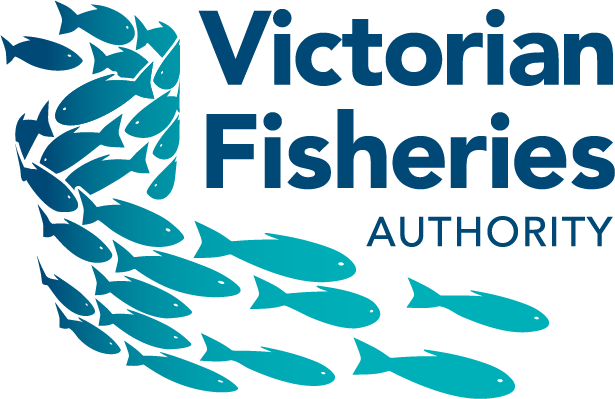Habitat Enhancement for Recreational Fish in Reservoirs and Lakes
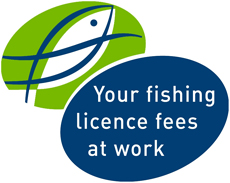
Report No. 26,
February 2006
Paul Brown
Table of Contents
Executive Summary
Location FAD1:
Location FAD2:
Introduction
Project Design and Methods
Literature Review Methodology
Aerial Photography
FADs - Lake Eildon
Literature Review
Fisheries management and evaluation
Construction
Socioeconomic costs & benefits
Sampling methods for evaluation
Fisheries response and effects on angling
Fish response to habitat enhancement
Australian studies
Mechanism of habitat use
Complexity
Substrate
Shade
Conclusions
Recommendations
Acknowledgements
References
Appendix 1- Example of aerial orthophotographs of Lake EildonAppendix 2 - Images of artificial habitat trial in Lake Eildon
Executive Summary
A comprehensive review of the available literature on the use of artificial habitat (AH) to enhance recreational fisheries in freshwater lakes and impoundments suggests that there are many cases (mainly in the USA) where sportfish species are successfully attracted to AH, and where anglers catch rates improve as a consequence. However, there are also examples where rigorous evaluation experiments show little evidence of 'attraction effect'. It also seems likely that production may only be enhanced in locations where, hardsubstrates are rare or non-existent (eg. softbottomed reservoirs).
To maximise the chance of successfully attracting sportfish species, careful choice of location is needed. Sites likely to benefit anglers the most are those where structural habitat for fish is not already abundant. Structures likely to work 'best', to be environmentally sustainable and aesthetically acceptable, are constructed of natural materials (eg. brush, timber, etc). Australian species that require hard-substrates and cover for nesting success (eg. Murray cod), may be expected to benefit from AH construction in waters where such habitat is limited. Two timber conical-shaped fish attracting devices (FAD's) were designed and constructed out of timber in Lake Eildon, Victoria. An information sign with a map and GPS coordinates of these FAD's is located at the Jerusalem Creek boat ramp:
Location FAD1:
Zone 55, Easting 408490, Northing 5875644
Location FAD2:
Zone 55, Easting 408065, Northing 5876507
Hi-resolution aerial photography of Lake Eildon, flown in July 2003, has been geo-referenced for use with geographic information systems. The images show the lake at low storage level (~12%,) and individual habitat features such as dead-trees, and river channels can be identified. These images can now be used to assist current and future research on habitat associations and fish behaviour.
Introduction
Man made aquatic structures are well known as having potential to concentrate, attract or enhance the production of fishes in many habitats. However, the majority of published knowledge in this field concerns freshwater instream habitat rehabilitation largely for salmonids (eg. salmon and trout) (Binns 1994; Flebbe and Dolloff 1995; Hildebrand et al. 1998; Huusko and Yrjana 1997; Linlokken 1997; Swales and O'Hara 1980; Thorn and Anderson 2001; Vetrano 1988). There is also a wealth of literature and experience regarding marine artificial reefs (for reviews see Grossman et al. 1997; Pickering and Whitmarsh 1997).
In southern Australia, freshwater habitat rehabilitation is a developing field with most emphasis again being directed at streams and rivers (Brown 2003).
Recent information published internationally about fish habitat enhancement in lakes and reservoirs comes predominantly from recreational fisheries management, for centrarchids (ie. basses and sunfish), in North America. It's also relevant to note that many of today's methods (Bryant 1992; Johnson and Lynch 1992), are actually adaptations of older artisanal fish-management and fishing practices, such as brush-parks, developed around the world (Amarasinghe et al. 2002; Jamu et al. 2003; Welcomme 2002
Project Design and Methods
A literature review is the first stage in a 3-part project funded through the Recreational Fishing Grant Program2003/04, from Recreational Fishing Licence revenue. The second stage of the project aimed to collect and collate aerial photography data to benchmark present habitat structures for future association with recreational fish species and/or for future habitat enhancement projects.
The third stage aimed to trial artificial-habitat in sites in a suitable recreational reservoir fishery. Experimental fish-aggregating devices, or FADs, will be designed and installed.
Literature Review Methodology
The literature review collates and reports an evaluation of the current state of knowledge on artificial habitat structures in freshwater impoundments both internationally and within Australia via a search of published literature and databases. Throughout this review, the emphasis will be on peer-reviewed, published articles in the scientific literature. This literature was found after searching the following sources:
- Reprint databases catalogued at PIRVic, Snobs Creek library
- Electronic WWW on-line cataloguing services (Ovid current contents, Science Direct, WebSpirs)
- Selected publications on-line from publishing houses of major science journals
- WWW search engines
While acknowledging that a body of knowledge also exists within recreational fishing journals authored by angling-journalists, such material is often of limited use, difficult to access, and hard to assess.
This report is mainly concerned with stage 1, although stages 2 and 3 are also briefly documented.
Aerial Photography
Aerial photography of Lake Eildon was flown in 2003, when the Lake was at a record-low storage level (~12% capacity, July 2003). The objective on Goulburn-Murray Water's part was to obtain accurate information on the topography above the low-water-level, and interpret this bathymetrically to estimate true storage volume. The objective on our part was to gain images of habitat features, then above the waterline, that would normally be fish-habitat below the waterline. These images when geo-referenced (by Hydro Tasmania Consulting) can be used within geographic information systems to add value to current and future research projects on fish-behaviour and habitat-use in the lake.
FADs –Lake Eildon
Information collated in the review was used in the design and implementation of two fish-attracting structures placed in Lake Eildon in Victoria in 2004. The existing conditions in Lake Eildon suggest that popular angling species may prefer proximity to large woody debris (eg. standing and fallen timber) for habitat. However, there has been no investigations that suggest physical habitat is a limiting feature of sportfish populations in this lake.
Consultations with the storage managers (Goulburn-Murray Water) indicated some reluctance to place structures in locations currently free of standing-timber (ie. where habitat was sparse). This was largely due to perceived safety-concerns for boating use of these areas. However, two low-risk locations were identified within an existing low-speed zone at Jerusalem Creek inlet.
At both sites disused wooden bridges existed, which are normally drowned by average storage conditions. Fallen timber trunks up to 8-m long, that were located near the bridge structure, were gathered and stacked by a caterpillar-tracked heavy excavation machine. A pyramid shaped fish attracting device (FAD) was constructed around each bridge structure (Appendix 2). Steel cable was used to tie the logs together and tie the FAD to the bridge. Each FAD was marked with a buoy on 5m of polypropylene line. A steel information sign was erected at the nearby boat-ramp informing boat users, and specifically angler's of the location and purpose of the FADs (Appendix 2.) Evaluation of the FADs was not included as part of the present project.
Literature Review
The literature on habitat enhancement for recreational fisheries in reservoirs and lakes can usefully be categorised into the following areas.
Fisheries management and evaluation
Artisanal fisheries around the world have seen the advantages of AH for 1000's of years. Brush and vegetation 'parks' in tropical lakes, lagoons and rivers are used to enhance the capture-rate from net fisheries. They vary in form and complexity from simple fish attracting devices, to a form of aquaculture. Welcomme (1972; 2002) reviews them in some detail, discussing construction, fishing methods, quantity (density) of wood used, species composition and yield of the catch and associated management issues.
In freshwater lakes, as in the marine environment, the particular design of artificial habitat (AH) may have a strong bearing on whether AH projects are successful in their aims. Moreover, design aspects can determine whether the AH contributes to overall fishery production, or simply aggregates fish somewhere where they can be targeted more efficiently by anglers (Pickering and Whitmarsh 1997). The marine literature is strongly dominated by these two linked issues (see reviews in Fisheries, April 1997), and it is not unreasonable to suppose that both apply to AH in freshwater lakes.
Artificial materials are sometimes shown to perform well, in their role as fish-attractors. Prince and Maughan (1978; 1979a) showed various types of submerged car tyre configurations worked well in attracting sportfish in Smith Mountain Lake, Virginia. Although, in a comparison of submerged 'cedar
trees' and 'fabricated polypropylene modules' in a strip mine impoundment in Kentucky, 78% of the observed fish used the natural materials compared to 17% using the modules and 5% in control areas (Rold et al. 1996).
More synthetic materials were compared in fisheries for pike (Esox lucius) and largemouth bass (Micropterus salmoides) where structures were constructed of plastic 'snow fencing', polyethylene drainage pipe, zip ties and a steel frame in various configurations (Rogers
and Bergersen 1999). The authors concluded that while such structures could attract bass to areas normally under utilised, they would be most valuable in lakes with little physical structure, poor aquatic plant growth, and where there was restricted angler access to existing structural features.
One report compared three types of structure including submerged evergreen trees, brush-beds and stake beds. The authors measured the habitat use by 'panfish' and the success of angler fishing over such structures. Of these structures Johnson and Lynch (1992), recommended evergreen trees for their attraction of target species and higher angler catch rates (>2 fish/hr). It was noted however, that evergreen trees may not last more than 'a few years' and may not be available in rural areas.
Fish attractors made from either vitrified clay pipes, or cement blocks and brush, were compared in a Florida lake. Both attractors yielded higher fishing success than did control areas (Wilbur 1978).
A more recent report (Wills et al. 2004), evaluated the use of two types of artificial cover on fish abundance and angler catches. Using a rigorous experimental design comparing treatment and reference (no-treatment) sites, before and after the covers were installed, they showed highly variable effects. Smallmouth bass were the only species to respond positively to the presence of one type of cover (half -logs). Even though smallmouth bass were more abundant, and had greater nesting success with this AH treatment there was no detectable influence on anglers catch rates. The authors noted that the response from the fish to the habitat structures was typically less than the differences between reservoirs and among reference and treatment sites within reservoirs. In conclusion Wills et al (2004), support the assertion that the lack of attraction of their AH was likely due to adequate existing habitat adjacent to their chosen sites.
Construction
While there are many case-studies such as these in the literature containing brief descriptions of the AH used, few contain detailed construction guidelines. A fact sheet from the Ohio State University detailed materials for AH structures; how deep to place structures; how much structure to add; and how to construct and place structures (Lynch 2004). These instructions again relate to stake bed, brush pile, and evergreen tree structures used in ponds and reservoirs for warm water sportfish.
The Reservoir Committee of the Southern Division of the American Fisheries Society conducted a survey of state agencies to identify:
- agency goals of habitat enhancements,
- preferences for different habitat enhancement methods,
- advantages and disadvantages of various habitat enhancement methods; and
- efforts to assess fish-population responses to habitat enhancements.
Biologists within each state who had conducted numerous habitat-enhancement efforts were sent written questionnaires to evaluate each type of structure (e.g., brush piles, substrate modifications) that had been used by the state agency. Issues canvassed included advantages/disadvantages of each method, agency goals for habitat enhancements, and a summary of efforts to assess fish-population responses to habitat enhancements. Their online Habitat Enhancement Manual (Tugend 2003) summarises the results of the survey and includes the opinions of the respondents. This is an excellent reference and contains good descriptive diagrams that would facilitate construction. A summary of the survey is also provided within Tugend et al. (2002).
Socioeconomic costs & benefits
Few studies reported in the research literature examine the cost of construction of AH although, there are likely to be many more examples within the 'grey' literature of agency reports etc.
In some parts of the world there are real environmental and financial costs associated with maintaining AH. With artisanal brush-park fisheries, deforestation of mangroves and other woody riparian vegetation is often the result of providing stakes and brush for the brush parks (Welcomme 2002). Cost of construction of experimental brush parks (10m x 10m) in Malawi in 2003 was US$233–290 (Jamu et al. 2003).
Lake Havasu on the Colorado River, supplies water to Los Angeles. It has been the subject of one of the largest AH-based recreational fisheries enhancement projects in the world (Anderson 2001). Forty-two sites totalling 875 acres were designated for habitat enhancement including installation of over 138,000 individual habitat 'units' (bass shelters, catfish houses, bass ambushing cover structures, tyre towers and brush bundles). The program focussed on three goals:
(i) "Improving game fish production by installing artificial reef habitat and providing physical habitat complexity to concentrate fish; (ii) enhancing shoreline angling access, including trails, restrooms and docks; and (iii) increasing endangered native fish populations." After eight years a comprehensive evaluation of socioeconomic benefits was conducted that concluded that " The resulting increase in fishing activity, and associated fishing related expenditures in the local area, have produced a significant, long term socioeconomic benefit to the local area, including increases in employment, income and tax revenues." While the fish surveys and angling catch data supports the idea that the Lake Havasu fishery has improved over the course of the project, there have also been changes in human demographics, fishing power (aka efficiency), and non-habitat related fisheries management that may also account for at least some of the increased socioeconomic impact.
Prince and Maughan (1978) reviewed the economics of rehabilitating Smith Mountain Lake with extensive tyre reefs and concluded, "research and practical experience indicate that artificial reefs used in structure-deficient (lake) environments are a biologically and economically viable fisheries management tool." While acknowledging that cost is among the important factors that limit the uptake of any fisheries management technique, they suggest that costs of artificial reefs can be limited by using durable construction materials and by making the project a community endeavour.
Sampling methods for evaluation
In a survey of U.S. State Fisheries agencies, 82% used some kind of habitat enhancement in Lakes and Reservoirs while only around 60% reported any evaluation of such structures. Most of this evaluation was testing for improvements in fish abundance or angler catch rates (Tugend et al. 2002).
Direct observation of sportfish by divers, or indirect observation using remote underwater camera was used in many studies (Bryant 1992; Graham 1992; Hayse and Wissing 1996; Johnson and Lynch 1992; Loffler 1997; Prince and Maughan 1978; Rold et al. 1996).
The most prevalent evaluation method amongst the research-literature is sampling catch-per-uniteffort either by electrofishing, netting or trapping (Clady et al. 1979; Freitas and Petrere 2001; Jamu et al. 2003; Larson et al. 1986; Lynch and Johnson 1989; Moyer et al. 1995; Saiki and Tash 1979; Wege and Anderson 1979; Welcomme 1972; Wilbur 1978).
Considering the overall goal of most studies was improving sportfishing, relatively few used angling catch per unit effort as an indicator of success (Paxton and Stevenson 1979; Wilbur 1978). Fishing tournament participation and size of fish caught by anglers was also used in the broadscale evaluation of the Lake Havasu fisheries improvement project (Anderson 2001).
Telemetric observations from radio- (Colle et al. 1989; Prince and Maughan 1979b), or acoustic tagged fish (Rogers and Bergersen 1999) were also rarely used to evaluate AH project success.
Fisheries response and effects on angling
In a study in a warmwater impoundment fishery in Florida, Wilbur (1978) noted statistically significant improved fishing success from the general public, and also during controlled fishing trials of two types of fish attractor device. Higher catches were also significant, in comparison with control sites, when he electrofished his attractors.
When individual species are considered, results may be more variable. In a study of a coolwater fishery in Ohio, controlled angling-survey effort was randomly allocated to artificial reefs with, and without, additional structure and to open-water control areas (Paxton and Stevenson 1979). Over a two-year period it was concluded that there was a general trend for increased harvest of basses and sunfishes over structured reefs. However, yellow perch and walleye were "not concentrated by artificial reefs, but were abundant from non-reef areas of the reservoir".
In a table summarising "fishing success for selected inland waters of the United States: artificial reefs versus non-reef areas", Prince and Maughan (1978) described the ratio of fishing success at artificial reefs: controls, and for artificial reefs: entire lake. They cite 21 published studies from 1957–1974. Results look convincing. For all fish species (pooled) results vary from 1.2:1 to 13.3:1 for reef:controls and from 3:1 to 40:1 for reef:entire lake comparisons. For a variety of bass and sunfish species targeted by sportfishers ratios of 1.7:1 for reefs:controls and 1.5:1 to 4.8:1 for reefs: entire lake were achieved. This is good evidence for increased fishing success caused by artificial reefs.
Fish response to habitat enhancement
Much of the research literature concerns warmwater fisheries in the USA where the target species are often basses and sunfishes. There are many examples showing increased indices of abundance from areas with AH compared to those without AH (see reviews in Johnson and Stein 1979; Prince and Maughan 1978). Indeed, no published examples of a failure to attract increased abundance of sportfish species were found. This may be the case, or it may simply reflect researchers' tendencies to only report the successes and ignore the failures.
Some of the benefits reported from the Lake Havasu fisheries improvement project include more stable size-structure and increased abundance and size of some target species (Anderson 2001).
In Lake Constance, on the border of Germany, Austria, and Switzerland artificial habitats were historically owned and used by private individuals and communities and provided "good yields of fish" (Loffler 1997). An experimental dome-shaped steel skeleton filled with brush was deployed and observed over two years. Redfin perch (a desirable species) initially occupied it, but were replaced with an undesired exotic species, the Ruffe. Redfin, and roach were also shown to spawn readily on brush bundles introduced to Salford Quays (a redeveloped freshwater dockland) in the UK (Nash et al. 1999). Similar brush bundles, wrapped in nets, to exclude predators, were found to harbour significantly more young-of-year redfin and cyprinid juveniles than controls in a Swedish lake (Sandström and Karås 2002).
AUSTRALIAN STUDIES
Australian bass fingerlings released into floating rafts of artificial cover, over deep water survived best in a comparative Queensland study. However, releases into shallow water did "almost as well", and there was little difference for barramundi and silver perch. Conversely, survival of golden perch fingerlings was much lower when released into artificial cover (Simpson et al. 2002).
'Spawning benches' and 'half-log' covers have been successfully used for black basses and other nest-building species in North America (Tugend et al. 2002).
Fish species diversity and assemblage structure was examined after introduction of artificial (tyre) reefs in Barra Bonita Reservoir and associated river-sites, in Brazil (Freitas and Petrere 2001). Netting surveys showed a significant increase in Shannon's species-diversity index in areas of the reservoir with reefs and attributed this to the increase in habitat complexity.
Mechanism of habitat use
Many studies have examined how and why artificial habitat works in efforts to enable designs to be optimised for particular applications (eg. species, situation, cost etc)
COMPLEXITY
It has been shown that the degree of protection from predators (largemouth bass) offered by natural vegetation or artificial habitat is related to the density of plant stems, or the complexity of the habitat (Crowder and Cooper 1979; Hayse and Wissing 1996). Some studies indicate, that this may be due to increases in the visual barriers provided by complex habitats (Savino and Stein 1982), in other words prey can hide better in more complex habitats.
Preference of some species for artificial habitat is also related to the size of the spaces within the structure (Johnson et al. 1988; Lynch and Johnson 1989; Walters et al. 1991). Prey species prefer interstitial spaces close to their body-size, and that preference is increased in the presence of predators. (Johnson et al.1988; Lynch and Johnson 1989; Walters et al. 1991).
Other species (eg. bullhead catfish, gizzard shad, and white crappies) also show a distinct preference for artificial habitat at a certain depth (Walters et al. 1991).
SUBSTRATE
It has been suggested that in lakes and ponds, a film of algal biomass colonising the hard-substrates of artificial habitat, in turn supports more invertebrates (secondary production) which allows increased production of fish (Prince and Maughan 1978). However, this theory remains largely untested. In fact, an experimental approach to the problem determined that the addition of wood surface-area up to 15% of a pond's surface area has no detectable effect on fish production (Pardue and Nielson 1979). Other pond trials have however shown that some species of predators show increased growth in the presence of brush-shelters, the authors attributing this to the structure's effects on increased predator efficiency and energetic efficiency.
As discussed above, where spawning substrate is limited, the addition of 'spawning benches' and 'half-log' covers, and tyre-reefs can be successful for nest-building species (Prince and Maughan 1978; Tugend et al.2002).
SHADE
The enhancement of overhead, shade-producing cover is an objective of many types of AH commonly deployed in the USA, including commercially available plastic "Fish-N-trees" (made by Plastics Research and Development Corporation (PRADCO)), and "Mushroom Hat Structures" made from conical tree-guards strung on a floating line above an anchor (Tugend 2003). Artificial floating objects are common (eg. FAD's) in the marine environment but there has been less exploration of their potential in freshwater lakes. Helfman (1979), showed that a variety of forage-fish species were attracted to floating platforms in a New York lake. The attraction of small fish to the floats was reduced under overcast weather conditions or at night, suggesting that hiding from predators was a key mechanism promoting a response to the floats. The author's observations indicated that relative visibility (horizontally) underwater was affected by the shade cast by the floating platform. In effect, an observer (ie. predator) had to move 40% closer to see an object under the float than in open water. The advantage works both ways, in that an observer in the shade (eg. a predator in ambush) could discern objects 20% further away (in open water) than when the observer was unshaded. Thus, AH offering shade should be attractive to both predator and prey fishes.
Conclusions
There is a convincing body of evidence that suggests installing physically complex structures in standing freshwaters will attract fish of many species. This attraction may in-turn be reasonably expected to produce better catch rates for anglers targeting fish at such structures. The construction material, configuration and location can all influence the colonising fish assemblage. Many authors report more pronounced effects where the original structural complexity of habitat was limited. Ideal candidate water bodies or locations within water-bodies, would be soft-bottomed, with little existing standing or fallen timber, and few aquatic plants. Many water bodies with strongly fluctuating water levels may fit this bill. Most are reservoirs used to supply water for irrigation, or domestic supply. However, they can present practical difficulties associated with installing large fixed structures (eg. navigation hazards, aesthetics etc). There is a range of designs for buoyant collapsible structures that may be suitable in such circumstances. The majority of recreational fisheries in southern Australia have developed within these fluctuating storage reservoirs. This may explain why there has been little progress in the subject of artificial habitat, and consequently little available literature to review.
The use of 'materials of opportunity' may make the economics of AH installation more attractive. However, the use of man-made 'scrap' items such as tyres now has rigorous controls, or is banned due to environmental/aesthetic concerns in most areas where it was a popular construction material in the 1970s. Natural, and ultimately biodegradable, material such as timber and brush is eminently more suitable in most applications.
Structures may improve production (primary, secondary etc) when suitable hard-substrates are limited in abundance, although results of trials are equivocal. Brush and timber structures are likely to increase habitat availability for both desirable (eg. native, or sportfish) species, and undesirable (eg. pest) species. Where lack of habitat is the limiting factor for fish abundance, adding structures may increase production. However, if other natural resources (e.g. food, or another habitat important to the fishes life-cycle) are limiting then increased overall production cannot be expected.
In Australia, nesting 'boxes' are commonly used to promote spawning in extensive aquaculture of Murray cod (Cadwallader et al. 1979; Cadwallader and Gooley 1985). Blackfish spawning has also been recorded in PVC tubes (Koehn 1987). It is likely that similar devices could promote spawning for Murray cod or blackfish in lake environments where hard substrates are rare. Suitable juvenile and adult habitat could also be constructed by combining brush and timber structures.
The present study has trialed the design and construction of two timber conical-shaped fish attracting devices in Lake Eildon, Victoria. The location of these structures was largely predetermined by the needs of the site managers (G-MW), and may not fit the ideal criteria proposed above. Nevertheless, they represent an opportunity to determine whether such structures are effective in attracting, and congregating sportfish species (eg. redfin, golden perch, Murray cod, brown & rainbow trout) in Victorian impoundments.
The development of a detailed aerial orthophotographic record of Lake Eildon at its record low-water level in 2003 will allow the future identification of areas within the reservoir where habitat may be limiting for sportfishes. This geographic information system (GIS) tool will add value to analyses of fish behaviour projects recently funded through the Recreational Fishing Grant Program2003/04, from Recreational Fishing Licence revenue.
Recommendations
That the FRAC note and consider this summary of the available literature on artificial habitat in freshwater lakes
That the effectiveness of the first two FADs installed as part of this project in Lake Eildon should be determined. Are these FADs attracting fish of interest to recreational anglers?
Due to the paucity of existing complex habitat structure, the lakes and reservoirs where further use of artificial habitat and/or FAD's are recommended include Bullen Merri, Lake Nillahcootie, and Waranga reservoir.
That fisheries and water managers use this review and recommendations to identify and prioritise other potential candidate-lakes and reservoirs for enhancement.
Acknowledgements
Thanks go to Goulburn-Murray Water (Geoff Harrison, Daryl Eaton and others) for assistance with aerial photography and with planning the FADs. Thanks also to Peter Grant and Russell Strongman of PIRVic for FAD construction and design of signage and thanks to Joel Tyndall for assistance with sourcing literature for the review.
References
Amarasinghe, U.S., Amarasinghe, M.D. and Nissanka, C. (2002) investigation of the Negombo estuary (Sri Lanka) brush park fishery, with emphasis on commuinity- based management. Fisheries Management and Ecology 9, 41-56.
Anderson, B.E. (2001) 'The Socio-Economic Impacts of the Lake Havasu Fisheries Improvement Program.' Andersons and Associates Economic and Social Impact Specialists.
Binns, N.A. (1994) Long-term responses of trout and macrohabitats to habitat management in a Wyoming headwater stream. North American Journal of Fisheries Management 14, 87-98.
Brown, P. (Ed.) (2003) 'Proceedings of the workshop on: Stream habitat rehabilitation for recreational fisheries.' (Marine and Freshwater Resources Institute: Snobs Creek)
Brown, P., Douglas, J., Gooley, G., . J. and Tennant, W. (1999) Biological assessment of aquatic habitat rehabilitation in the Broken River and Ryans Creek, north east Victoria. In 'Second Australian Stream Management Conference'. Adelaide. (Ed. R Bartley) pp. 137-142. (Cooperative Research Centre for Catchment Hydrology)
Bryant, G.J. (1992) 'Direct Observations of Largemouth and Smallmouth Bass in response to various Brush structure Designs in Ruth Reservoir, California.' USDA Forest Service Pacific Southwest region.
Cadwallader, P.L., Backhouse, G.N., Gooley, G.J. and Turner, J.A. (1979) New techniques for breeding and raising Murray cod. Australian Fisheries 38(9), Sep-16.
Cadwallader, P.L. and Gooley, G.J. (1985) 'Propagation and rearing of Murray cod Maccullochella peeli at the Warmwater Fisheries Station Pilot Project Lake Charlegrark.' (Fisheries and Wildlife Service, Department of Conservation, Forests and Lands: Melbourne)
Clady, M.D., Summerfelt, R.C. and Tafanelli, R. (1979) Effectiveness of Floating Tire Breakwaters for increasing Density of Young Largemouth Bass in coves of an Oklahoma Reservoir. In 'Response of fish to habitat structure in standing water'. (Eds DL Johnson and RA Stein) pp. 38-43. (American Fisheries Society: Bethesda, Maryland)
Colle, D.E., Caliteux, R.L. and Shireman, J.V. (1989) Distribution of Florida Largemouth Bass in a Lake after Elimination of All Submersed Aquatic vegetation. In 'North American Journal of Fisheries Management')
Crowder, L.B. and Cooper, W.E. (1979) Structural Complexity and Fish-Prey Interations in ponds:A Point of View. In 'Response of fish to habitat structure in standing water'. (Eds DL Johnson and RA Stein) pp. 2-8. (American Fisheries Society: Bethesda, Maryland)
Flebbe, P.A. and Dolloff, C.A. (1995) Trout use of woody debris and habitat in Appalachian wilderness streams of North Carolina. North American Journal of Fisheries Management 15, 579-590.
Freitas, C.E.C. and Petrere, M.J. (2001) Influence of artificial reefs on fish assemblage of the Barra Bonita Reservoir (São Paulo, Brazil). Lakes & Reservoirs: Research and Management 6, 273-278.
Graham, R.J. (1992) Visually Estimating Fish Density at Artificial structures in Lake Anna, Virginia. North American Journal of Fisheries Management 12, 204--212.
Grossman, G.D., Jones, G.P. and Seaman, W.J.J. (1997) Do artificial reefs increase regional fish production? A review of existing data. Fisheries, 17-23.
Hayse, J.W. and Wissing, T.E. (1996) Effects of stem Density of Artificial Vegetation on Abundance and growth of Age-O Bluegills and Predation by Largenouth Bass. Transactions of the American Fisheries Society 125, 422-433.
Helfman, G.S. (1979) Fish attraction to floating objects in lakes. In 'Response of fish to habitat structure in standing water'. (Eds DL Johnson and RA Stein) pp. 49-57. (American Fisheries Society: Bethesda, Maryland)
Hildebrand, R.H., Lemly, A.D., Dolloff, C.A. and Harpster, K.L. (1998) Design considerations for large woody debris placement in stream enhancement projects. North American Journal of Fisheries Management 18, 161-167.
Huusko, A. and Yrjana, T. (1997) Effects of instream enhancement structures on brown trout, Salmo trutta L., habitat availability in a channelized boreal river: a PHABSIM approach. Fisheries Management and Ecology 4, 453-466.
Jamu, D.M., Chaula, K. and Hunga, H. (2003) A priliminary study on the feasibility of using fenced brushparks for fish production in Lake Chilwa, Malawi. Naga, WorldFish center Quarterly 26, 5-8.
Johnson, D.l., Beaumier, R.A. and Lynch, W.E. (1988) Selection of Habitat Structure interstice Size by Bluegills and Largemouths Bass in ponds. Trans. Amer. Fish, Soc. 117, 171-179.
Johnson, D.L. and Lynch, W.E.J. (1992) Panfish Use of and Angler Success at Evergreen Tree, Brush, and Stake-Bed Structures. North American Journal of Fisheries Management 12, 222-229.
Johnson, D.L. and Stein, R.A. (1979) 'Response of fish to habitat structure in standing water.' (North Central Division American Fisheries Society: Bethesda, Maryland)
Koehn, J.D. (1987) Artificial habitat increases abundance of two-spined blackfish (Gadopsis bispinosis) in Ovens River, Victoria.
Larson, E.W., Johnson, S.L. and Lynch, W.E.J. (1986) A Buoyant Pop Net for Accurately Sampling Fish at Artificial Habitat Structures. Trans. Amer. Fish, Soc. 115, 351-355.
Linlokken, A. (1997) Effects of instream habitat enhancement on fish populations of a small Norwegian stream. Nordic Journal of Freshwater Research 73, 50-59.
Loffler, H. (1997) Artificial habitats for fishes in Lake Constance ( Bodensee): observation of fish aggregating devices with a remotely operated vehicle. Fisheries Management and Ecology 4, 419-420.
Lynch, W.E. (2004) 'Placing Artificial Fish Attractors in Ponds and Reservoirs' internet site, http://ohioline.osu.edu/a-fact/0001.html
Lynch, W.E. and Johnson, D.L. (1989) Influences of Interstice size, Shade, and Predators on the Use of Artificial studtures by BLuegills. North American Journal of Fisheries Management 9, 219-225.
Moyer, E.J., Hulon, M.W., Sweatman, J.J., Butler, R.S. and Williams, V.P. (1995) Fishery responses to habitat restoration in Lake Tohopekaliga, Florida. North American Journal of Fisheries Management 15, 591-595.
Nash, K.T., Hendry, K. and Cragg-Hine, D. (1999) The use of brushwood bundles as fish spawning media. Fisheries Management and Ecology 6, 349-355.
Habitat Enhancement for Recreational Fish in Reservoirs and Lakes 13
Pardue, G.B. and Nielson, L.A. (1979) Invertebrate Biomass and Fish Production in ponds with Added Attachment Surface. In 'Response of fish to habitat structure in standing water'. (Eds DL Johnson and RA Stein) pp. 34-37. (American Fisheries Society: Bethesda, Maryland)
Paxton, K.O. and Stevenson, F. (1979) Influence of Artificial Structures in Angler Harvest from Killdeer Reservoir, Ohio. In 'Response of fish to habitat structure in standing water'. (Eds DL Johnson and RA Stein) pp. 70--76. (American Fisheries Society: Bethesda, Maryland)
Pickering, H. and Whitmarsh, D. (1997) Artificial reefs and fisheries exploitation: a review of the 'attraction versus production' debate, the influence of design and its significance for policy. Fisheries research 31, 3959.
Prince, E.D. and Maughan, O.E. (1978) Freshwater Artificial Reefs:Biology and Economics. Fisheries 3, 5-9.
Prince, E.D. and Maughan, O.E. (1979a) Attraction of Fishes to Artificial tire Reef's in Smith Mountain Lake, Virginia. In 'Response of fish to habitat structure in standing water'. (Eds DL Johnson and RA Stein) pp. 19--25. (American Fisheries Society: Bethesda, Maryland)
Prince, E.D. and Maughan, O.E. (1979b) Telemetric Observations of Largemouth Bass near Underwater Structures in Smith mountain Lake, Virginia. In 'Response of fish to habitat structure in standing water'. (Eds DL Johnson and RA Stein) pp. 26-33. (American Fisheries Society: Bethesda, Maryland)
Rogers, K.B. and Bergersen, E.P. (1999) Utility of Synthyetic Structures for Concentrating Adult Northern Pike and Largemouth Bass. North American Journal of Fisheries Management 19, 1054-1065.
Rold, R.E., McComish, T.S. and Van Meter, D.E. (1996) A comparison of Cedar Trees and Fabricated Polypropylene Modules as fish Attractors in a Strip Mine Impoundment. North American Journal of Fisheries Management 16, 223-227.
Saiki, M.K. and Tash, J.C. (1979) Use of cover and dispersal by crayfish to reduce predation by largemouth bass. In 'Response of fish to habitat structure in standing water'. (Eds DL Johnson and RA Stein) pp. 44-49. (American Fisheries Society: Bethesda, Maryland)
Sandström, A. and Karås, P. (2002) Tests of artificial substrata as nursery habitat for young fish. Journal of Applied Ichthyology 19, 102--105.
Savino, J.F. and Stein, R.A. (1982) Predator-Prey Interaction between Largemouth Bass and Bluegills as Influenced by simulated, Submersed Vegetation. Transactions of the American Fisheries Society 111, 255266.
Simpson, B., Hutchison, M., Gallagher, T. and Chilcott, K. (2002) 'Fish stocking in impoundments: A best practice manual for eastern and northern Australia.' (Queensland Govenment Department of Primary Industries: Deception Bay, Queensland)
Swales, S. and O'Hara, K. (1980) Instream habitat improvement devices and their use in freshwater fisheries management. Journal of Environmental Quality 10, 167-179.
Thorn, W.C. and Anderson, C.S. (2001) 'Comparison of two methods of habitat rehabilitation for brown trout in a southeast Minnesota stream.' Minnesota Department of Natural Resources, Investigational Report 488, Minnesota.
Tugend, K. (2003) 'Habitat Manual for Use of Artificial Structures in Lakes and Reservoirs' internet site
Tugend, K., Allen, M.S. and Webb, M. (2002) Use of artificial Habitat structures in U.S lakes and reservoirs: A survey from the southern division AFS Reservoir Committee. Fisheries, 22-27.
Vetrano, D.M. (1988) 'Unit construction of trout habitat improvement structures for Wisconsin coulee streams.' Department of Natural Resources, Administrative Report No. 27, Wisconsin.
Walters, D.A., Lynch, W.E. and Johnson, D.L. (1991) How Depth and Interstice Size Stuctures Influence fish Attraction. North American Journal of Fisheries Management 11, 319-329.
Wege, G.J. and Anderson, R.O. (1979) Influence of Artificial Structures on Largemouth Bass and Bluegills in small ponds. In 'Response of fish to habitat structure in standing water'. (Eds DL Johnson and RA Stein) pp. 59--69. (American Fisheries Society: Bethesda, Maryland)
Welcomme, R.L. (1972) An evaluation of the acadja method of fishing as practised in the coastal lagoons of Dahomey ( West Africa). Journal of Fish Biology 4, 39-55.
Welcomme, R.L. (2002) An evaluation of tropical brush and vegetation park fisheries. Fisheries Management and Ecology 9, 175-188.
Wilbur, R.L. (1978) Two Types of Fish Attractors Compared in Lake Tohopekaliga, Florida. Transactions of the American Fisheries Society 107, 689-695.
Wills, T.C., Bremigan, M.T. and Hayes, D.B. (2004) Variable Effects of Habitat Enhancement Structures across Species and Habitats in Michigan Reservoirs. Transactions of the American Fisheries Society 133, 399--411.
Appendix 1- Example of aerial orthophotographs of Lake Eildon
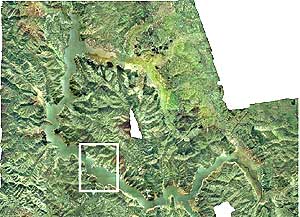
Complete coverage of Lake Eildon at 12% storage level.
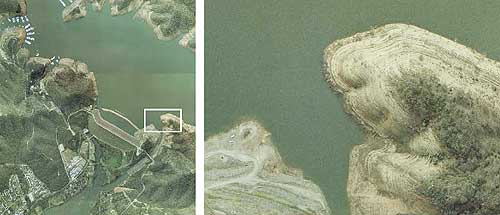
Photographs are geo-referenced for use in geographic information systems. Box shows area in further detailed left.
Hi-resolution images of Lake Eildon are now available, to assist planning of habitat management. This one (left) shows the dam wall with the crest of the old Sugarloaf dam wall and spillway clearly visible the boxed area, Dethridge point, is shown to the right with 2 vehicles and individual trees clearly visible.
Appendix 2 - Images of artificial habitat trial in Lake Eildon
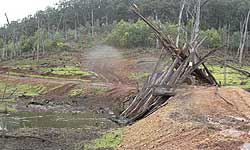
Creek, Lake Eildon.
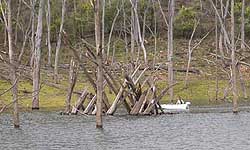
flooding Jerusalem Creek, Lake Eildon.
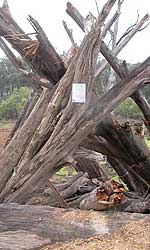
Lake flooding Jerusalem Creek, Lake Eildon.
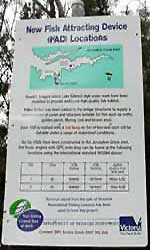
boat Ramp.
